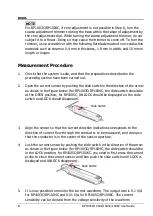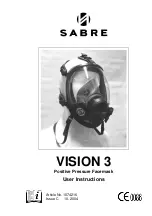
RIGOL
4
RP1003C/1004C/1005C/1006C User Guide
Parts Introductions
1.
Opening lever
It is used to open and lock the current sensor. You are recommended to lock the
current sensor when measuring the conductor to be measured to avoid danger.
For RP1003C/RP1004C, there are OPEN, FREE and LOCK indications on one side
of the slide switch. The on/off status of the current sensor is related to the
position of the slide switch.
When the slide switch is in the OPEN position, the current sensor is open
and at this point, the conductor to be measured can be connected to the
current sensor;
When the slide switch is in the FREE position, the current sensor is closed
but not locked;
When the slide switch is in the LOCK position, the current sensor is locked
and at this point, the UNLOCK indication is covered (cannot be seen).
For RP1005C/RP1006C, there are LOCK and UNLOCK indications on the slide
switch. The current sensor is locked when the LOCK indication is displayed on
the slide switch (the UNLOCK indication disappears).
2.
Sensor head
This clamps the conductor being measured, and carries out the actual current
measurement. It is a precision assembly that contains a molded component, a
ferrite core, and a Hall effect element. It may be damaged if subjected to
sudden changes at ambient temperature, or mechanical strain or shock, and
therefore great care should be exercised in handling it.
3.
Demagnetizing switch (DEMAG)
This demagnetizes the core if it has been magnetized by switching the power on
and off, or by an excessive input. Always carry out demagnetizing before
measurement.
The demagnetizing process takes about one second (RP1003C/RP1004C) or
three seconds (RP1005C/RP1006C).
During demagnetizing, a demagnetizing waveform is output.
4.
Zero adjustment dial (ZERO ADJ)
Use the zero adjustment dial to correct the voltage offset or temperature drift
on the device. When beginning the measurement, always carry out zero
adjustment after demagnetizing.
5.
Coarse adjustment trimmer (Only for RP1003C/RP1004C)
Use this only when adjustment is not possible within the range of the zero
adjustment dial. Use a nonconductive screwdriver (e.g. ceramic driver) for
adjustment.
Summary of Contents for RP1003C
Page 1: ...User Guide RP1003C 1004C 1005C 1006C Current Probe Sept 2020 RIGOL TECHNOLOGIES CO LTD ...
Page 2: ......
Page 10: ......
Page 29: ...RIGOL RP1003C 1004C 1005C 1006C User Guide 19 RP1005C RP1006C ...
Page 31: ...RIGOL RP1003C 1004C 1005C 1006C User Guide 21 RP1005C RP1006C ...
Page 33: ...RIGOL RP1003C 1004C 1005C 1006C User Guide 23 RP1005C RP1006C ...















































